Installation of wall and floor installation of the toilet

Not so long ago, interesting alternatives to simple floor-standing toilets appeared on the market - suspended installations. Today they are chosen by many consumers, noting the interesting design of such products. But not all users know how to properly install such plumbing items. This article will discuss how to install simple and suspended installations.
What it is?
The installation is a special system, which is a well-thought-out design that allows the toilet bowl and other plumbing fixtures to be fixed as securely and firmly as possible. In addition, such elements are necessary to hide the plumbing connections.

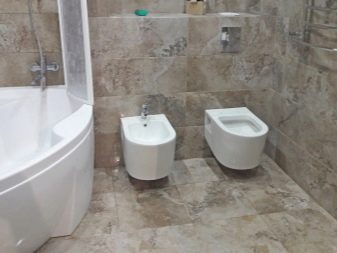
Peculiarities
According to consumers and experts, modern suspended and floor installations are very comfortable. Using such an interesting system, you can put the toilet in such a way that its cistern is safely hidden behind the wall. At the same time, it is additionally protected by a heat-insulating material, which provides sound insulation of the plumbing during its use.
When installing the installation, only the toilet bowl itself is always visible. Thanks to this feature, the room in the bathroom or toilet will seem much more spacious, even if in fact its area is modest.
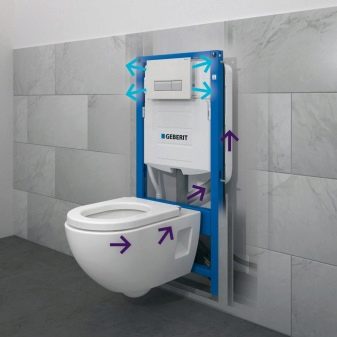
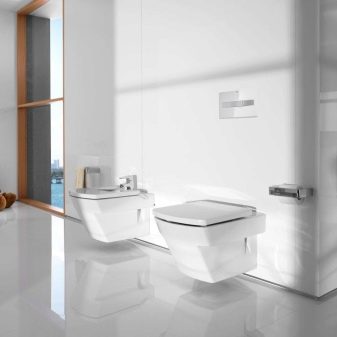
Professionals say that the installation of such systems can be done by hand. To do this, you just need to stock up on all the necessary tools and strictly follow the step-by-step instructions. Of course, if you are not very confident in your own abilities or are afraid to take on such work, then you better call experienced craftsmen,
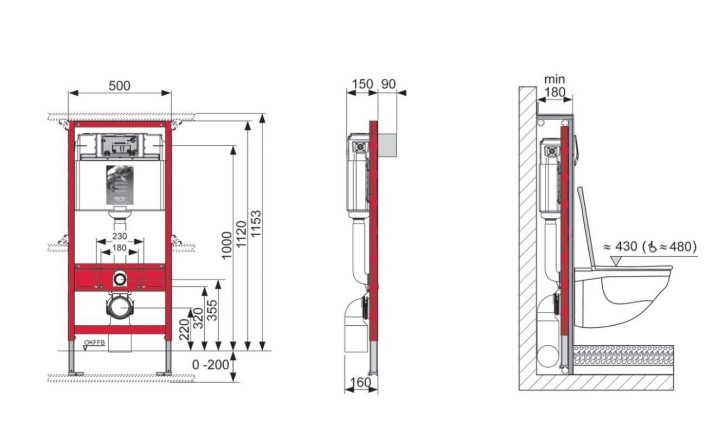
If you decide to install a floor or suspended installation in your home, then you should familiarize yourself with the advantages and disadvantages of such systems. Let's start by looking at their pros.
- First of all, it should be noted the compact size of such products. Thanks to this characteristic, suspended or floor installations can be installed even in very small rooms, where every centimeter counts.
- Such systems are distinguished by quiet operation, since the toilet cisterns are hidden behind the walls.
- Many housewives note that it is much easier to clean rooms with such structures - there are fewer hard-to-reach areas.
- If you decide to install a suspended structure, then you will have the opportunity to lay out a mosaic or a beautiful tile pattern on the floor - nothing will interfere with such a composition, violating the integrity of the pattern.
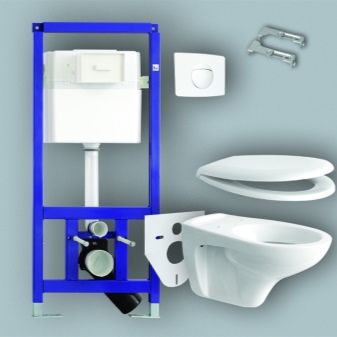
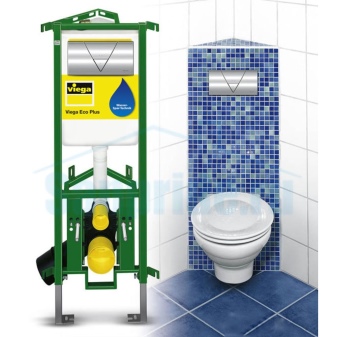
- Correctly installed installations save water. This is due to the fact that there are two buttons in such designs. One of them is responsible for a large flow of water, and the second for a small one.
- Such types of plumbing are not susceptible to damage. If they do happen, then they can be easily eliminated.
- Installations are quite acceptable to install in a "Khrushchev" environment.
- Suspended and floor installations are reliable and durable structures. They can easily withstand impressive loads (up to 400 kg). Of course, this advantage takes place if the toilet has been installed correctly and the bowl itself is made of quality material.
- Suspended and floor installations look very original. Their design attracts attention and makes the interior of the bathroom or toilet more stylish and modern.
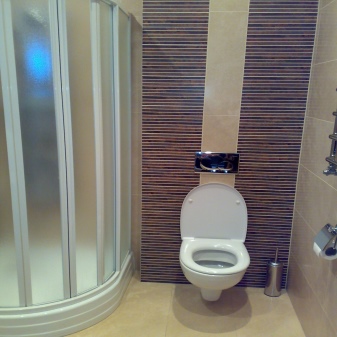
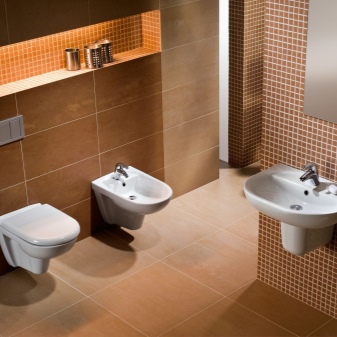
Installations also have their weaknesses, let's consider them in more detail.
- Such systems are not cheap.It should also be taken into account that, coupled with additional expenses for installation work, such a design can cost a tidy sum.
- In such structures, there are always hidden elements that become inaccessible for repair and maintenance.
- Replacing classic toilets is a fairly straightforward job, but if you decide to replace the installation, you will most likely have to renovate the entire room.

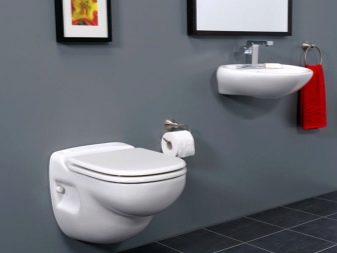
Views
There are several types of suspended and floor installations. Let's get to know them better.
Blocky
Block installations have support posts and fasteners. Such structures can be used for the installation of both floor-standing and suspended products. Block systems are reliable, robust and durable. Their installation is considered fairly straightforward.
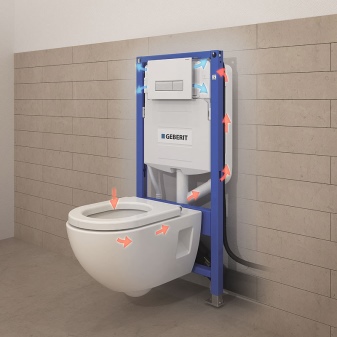
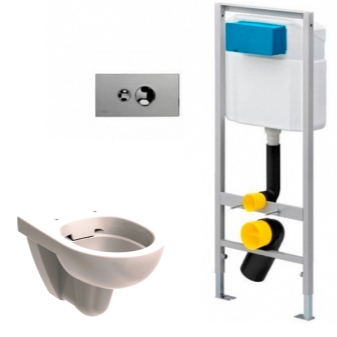
However, block installations have one serious drawback - they require the mandatory presence of a main wall in the room.
Framework
The frame (or frame) system is no less reliable, strong and durable. These structures can easily withstand loads of up to 400 kg.
Frame options can be attached to four points on the wall or two points on the floor and two points on the ceiling. Sometimes such structures are installed directly on the floor.
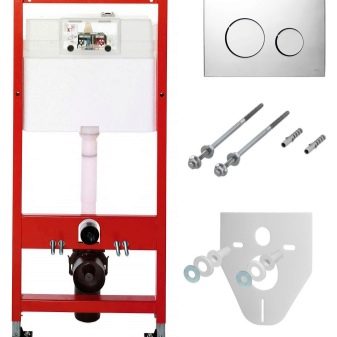
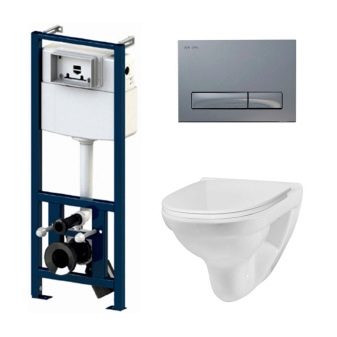
Frame structures do not require a main wall, like block options. Such systems can be mounted not only on concrete and brick, but even on gypsum board partitions.
These structures are based on a sturdy steel frame. You can install not only a toilet bowl on it, but also other additional elements. For example, it could be a sink or bidet. Installation of the frame system is possible not only near a straight wall, but also in the corner.
Corner
If you want to choose an original and fashionable design, far from the usual standards, then you should pay attention to corner installations. However, it should be borne in mind that such a structure can be installed only if the room has right angles at 90 degrees.
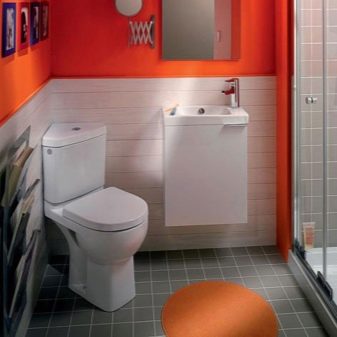
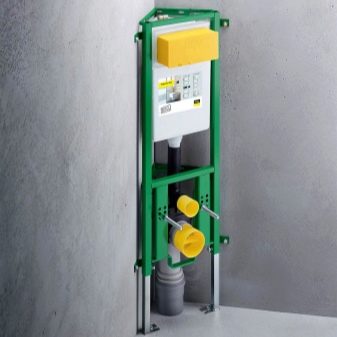
The installation of corner products is more difficult. In addition, such installations are more expensive than other options.
Varieties of toilets
Contrary to popular belief, toilets can be different. They differ in the shape of the bowl, the method of flushing, the release into the sewer system and the material of manufacture.
By the look of the bowl
Toilets are equipped with bowls of different shapes.
- One of the most popular are the funnel-shaped models. They have a number of advantages for which many buyers choose them. The main thing is that the funnel-shaped products are hygienic, since in this design the funnel is located in the central part of the bowl. Funnel-shaped models have no serious drawbacks, however, when using them, the probability of a burst is high.

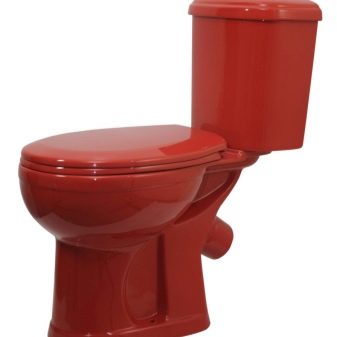
- The second most popular are bowl-shaped toilet bowls. They are simple flat platforms. Such models are cleaned only under the action of a water jet. Such models are considered obsolete, but differ in that they exclude splashing. Unfortunately, dish-shaped bowls cannot be called highly hygienic, which is why they have not been so popular lately.
- And there are also common visor bowls. In such products, there is a special protrusion that prevents the formation of a splash, as well as a slope, with which the walls of the toilet bowl are cleaned.
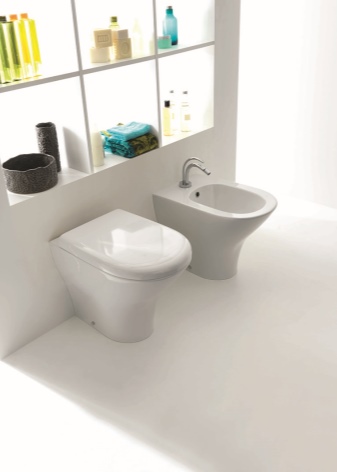
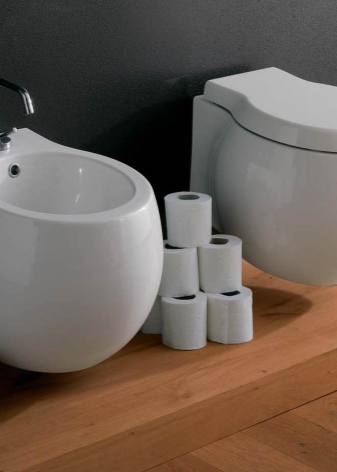
By type of flush
Toilets also differ in the way they are flushed. This parameter depends on the direction of water flows. Modern manufacturers produce toilets with direct and circular flush.
- Direct rinsing takes place by means of a stream of water on one side of the bowl. Such models are durable and reliable, but they do not guarantee sufficient flushing of the entire surface of the toilet. In addition, these products are quite noisy and generate a lot of splashing. But models with such a flush are inexpensive.
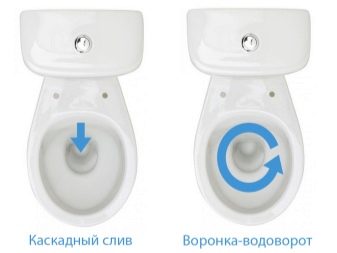
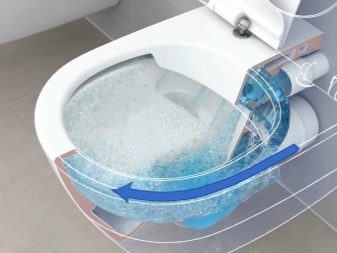
- As for the circular flush, then in it the jets of water are directed at different angles and move in different directions. Thanks to this system, up to 95% of the bowl surface is processed and cleaned. In addition, rim flush toilets are not noisy.
- Less common are toilets with non-standard flushing systems, which provide for the preliminary filling of the bowl with water, and then its quick drain. With this method, the flush fills the entire toilet bowl. The disadvantages of such products include excessive consumption of water during operation. This figure can exceed 8 liters.
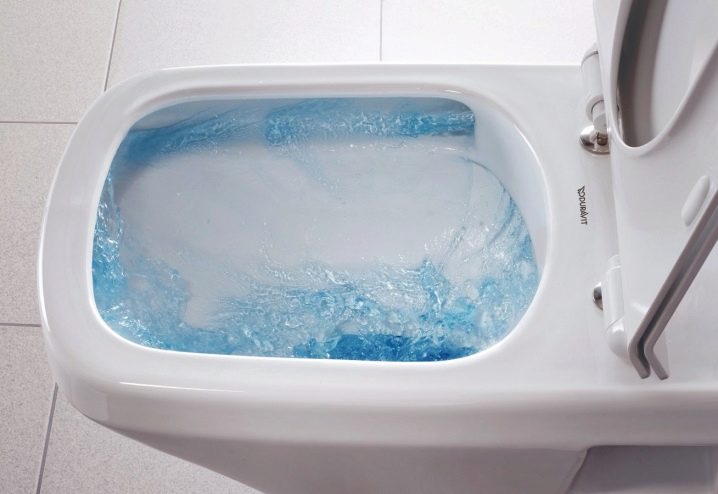
By release to the sewerage system
Modern types of toilets also differ in the way they are discharged into the sewer.
- The oblique method was popular for the construction of riser structures in apartment buildings of the 70-80s of the last century.
- Horizontal descent is the most common in our time. Most of the current buildings are designed to use toilet bowls with this system.
- And also there is a vertical descent. Today such systems are used in both American continents.
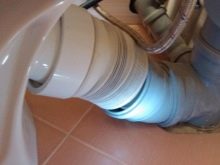
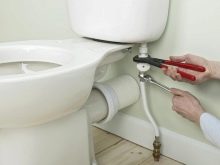
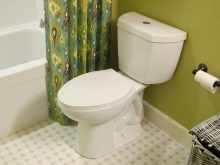
By material of manufacture
Floor-standing and wall-mounted toilets are made from different raw materials. Each model has its own characteristics and positive qualities. Let's take a closer look at what materials modern toilets are made of.
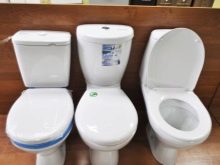
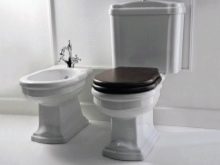
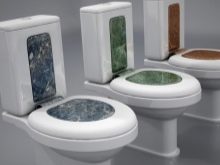
Faience
Toilets made of a material such as earthenware cannot boast of high durability. And also they have a small porosity, so cleaning such products is not an easy task. Currently, such raw materials are not used so often, since as a result, very fragile objects are obtained from it, on which chips, cracks and other mechanical damage easily remain.

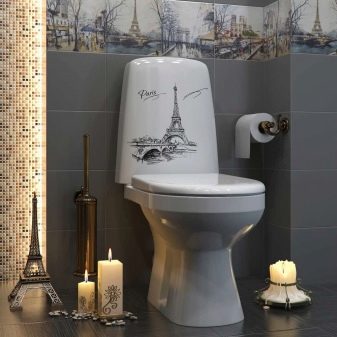
Of course, in modern production, special technologies are used, thanks to which faience plumbing becomes more reliable, however, faience is much inferior to other materials from which toilets of various modifications are made.
Porcelain
Porcelain toilets are stronger and more durable. They are easy to clean. Such models can often be found in public institutions, since they can easily withstand impressive loads and do not fail at the same time.
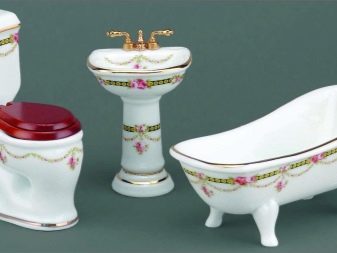
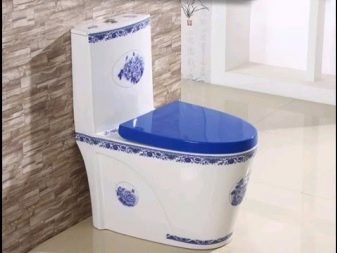
As for the disadvantages of porcelain toilets, they include the high cost of such products. To keep costs down, more affordable ceramic pieces have become popular.
Steel and cast iron
Metal plumbing belongs to the classics. Metal toilets are most often found in public places. Such products are distinguished by durability, strength and wear resistance. They are nearly impossible to damage or scratch. Steel and cast iron structures can easily withstand heavy loads.
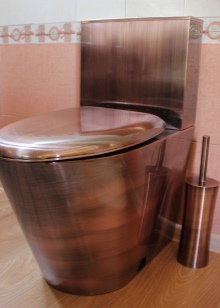

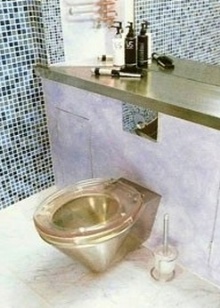
The disadvantages of such products include the relatively high cost. Cast iron toilets are considered the least popular, as they have an impressive weight and poor durability of the enamel coating.
Stone and glass
Glass and stone toilets (natural or artificial) are classified as Art Nouveau products. Such plumbing items are expensive, but they have an elegant and attractive appearance.
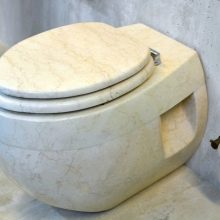
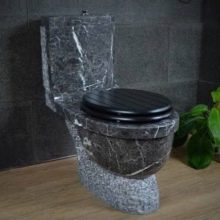
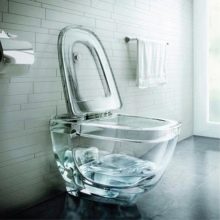
Glass models cannot boast of excellent strength characteristics. However, there are many analogues of glass and stone, from which equally beautiful toilets are made, which are more reliable, but inexpensive.
Plastic
Thanks to modern technology, you can find toilet bowls made of material such as reinforced acrylic on sale. Many consumers mistakenly believe that such products are not durable. In fact, this is not the case. Acrylic models have a long service life. In addition, such products are quite practical - they have almost no porous surfaces, so they can be easily cleaned of any contamination.
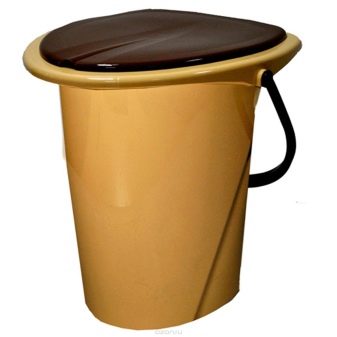
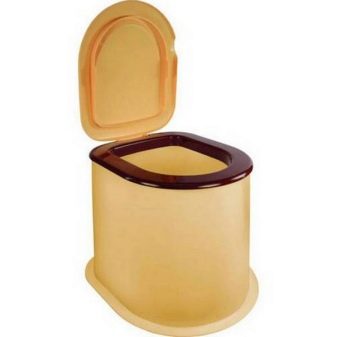
The disadvantage of such plumbing is its susceptibility to deformation, which can be caused by mechanical stress or too high temperatures.
Flush plates
For modern installations, special buttons are available. As a rule, they are quite large, since it is through them that you can get to the hidden cistern.
If necessary, the button can be easily removed from the special latches using a simple thin screwdriver. After that, the decorative panel that surrounds the button is unscrewed. Similarly, other similar structures are dismantled.
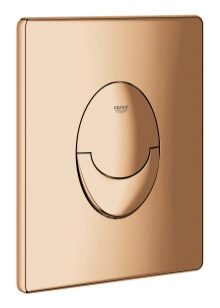
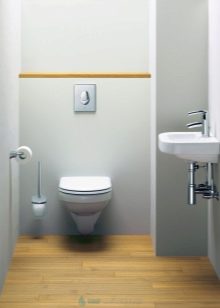

If you have a pneumatic stop-drain button installed, then the causes of problems with such structures may be:
- failure in the power supply system;
- malfunction in the shut-off valve opening system.
To fix a pneumatic button, you need special knowledge. If you have not worked with such elements before, then you should call the wizard.


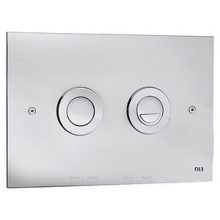
There are also touch buttons. Such details look interesting, and they are convenient to use. It is worth considering that the lion's share of touch button breakdowns occurs due to violations of the integrity of the supply cable. Only an experienced person should repair such mechanisms.
Accommodation options
Regardless of what kind of installation you have chosen, it is necessary to start installation work with a competent choice of a place for the toilet. In city apartments of a standard layout, a truly suitable space can be distinguished - a niche in which there are plumbing and sewerage risers.
To install the installation, you will need to slightly alter the niche by placing risers in the corners. If they are made of metal, then it is recommended to replace them with plastic ones.
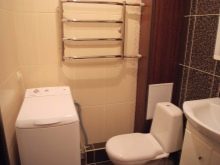
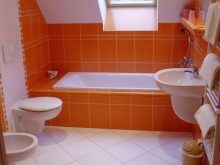
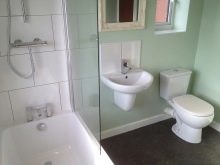
Before proceeding with the installation work, it is necessary to apply the correct markings. To do this, you need to know the exact dimensions of the installation.
Dimensions (edit)
Currently, the stores sell toilets and installations of various sizes. However, the standard dimensions of the floor-standing models are 520x340 cm. The seat height in such variants is 400 mm. There are models of toilet bowls that have an increased length of 7-10 cm (such models are especially popular in America).
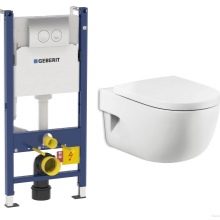
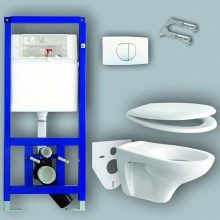
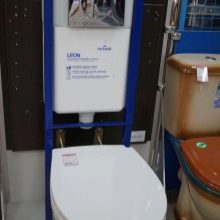
Suspended specimens have different parameters:
- small models are no more than 54 cm long (great for compact rooms);
- medium ones are available in lengths from 54 to 60 cm (they are considered optimal products, the most convenient to use);
- large models with an increased length of up to 70 cm (ideal for elderly and obese users with disabilities).
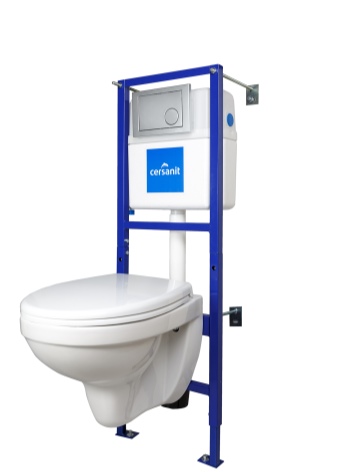
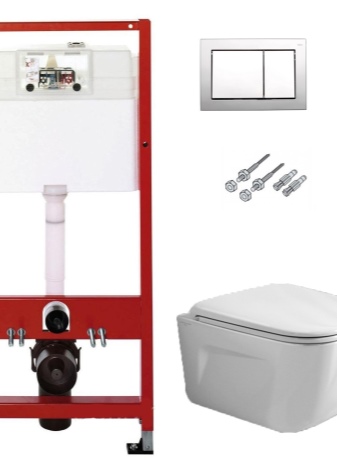
What is included?
The set of floor and pendant installations includes the following components:
- frame;
- toilet bowl;
- seat with cover;
- tank;
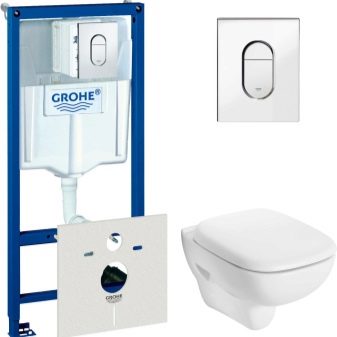
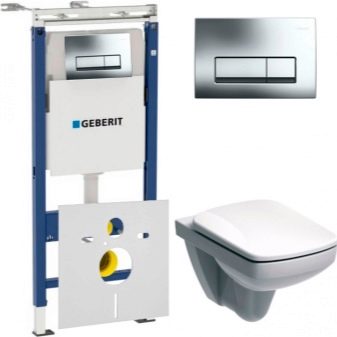
- outlet pipe;
- soundproofing;
- flush buttons;
- fasteners.
Mounting
Many owners believe that it is very difficult to install the installation, and it is not within their power to cope with such work. In fact, this is not the case. Let's consider step by step how to properly mount such a system with your own hands.
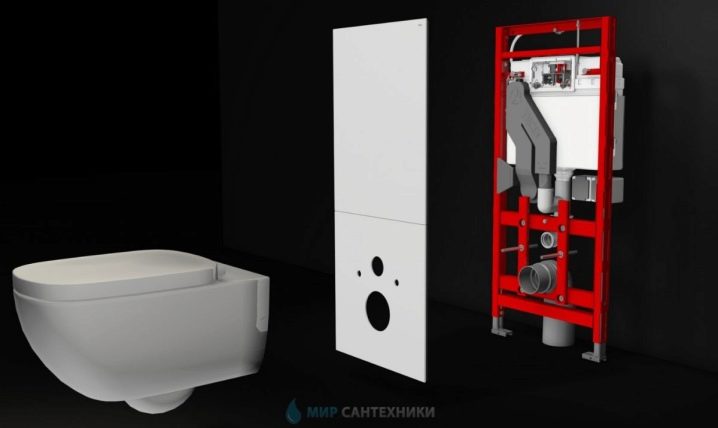
Instruments
To install a floor or pendant installation yourself, you will need the following tools:
- laser or bubble level (choose the tool that will be more convenient for you to work with);
- a special construction pencil or marker for marking;
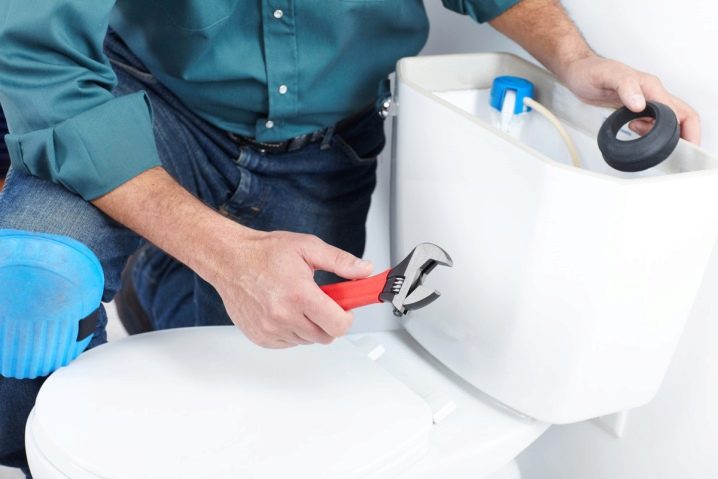
- puncher;
- drill for concrete;
- roulette;
- open-end keys (overhead).
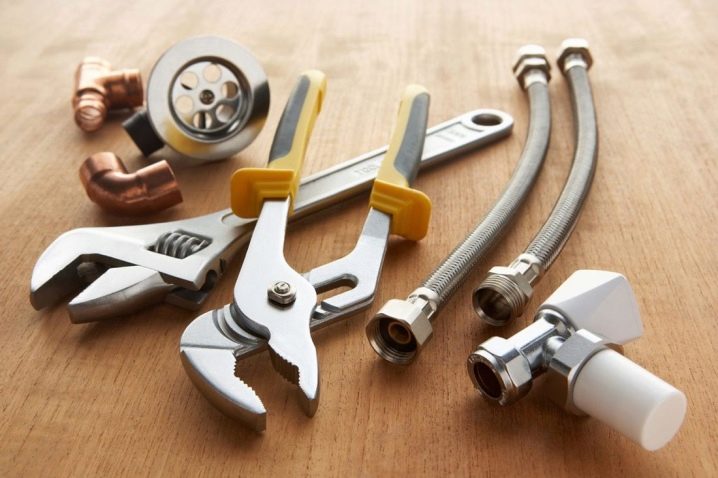
Preparatory work
Installations assume the presence of a separate niche in the room, in which the frame will be located. It should be borne in mind that the walls in the room must be quite reliable and strong.
A niche in a room should have the following parameters:
- 1000 mm high;
- 600 mm wide;
- 150-200 mm deep.
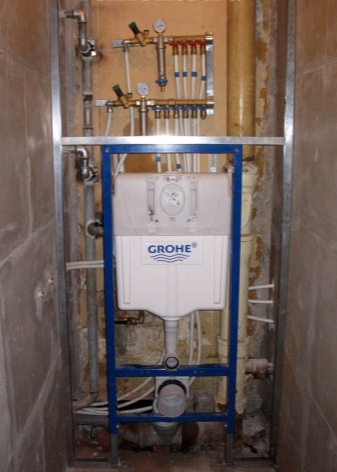
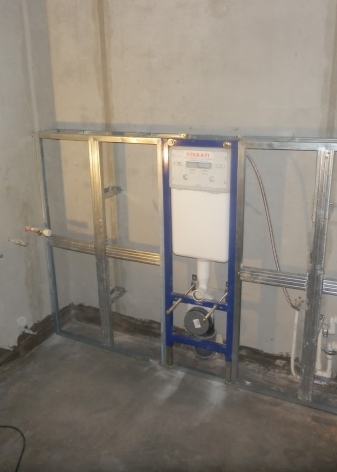
There are times when depth requirements are difficult to meet. Then the niche needs to be made as deep as possible.At the same time, its disadvantage should be sheathed (closed) with plasterboard and covered with a finishing material.
Installation
After preparing the niche, you can proceed to the installation of the installation.
- First you need to fix the metal frames to the wall. As a rule, in these structures there are initially holes, with the help of which the frames are attached to the dowels.
- There should be two attachment points - to the wall and to the floor.
- Further, it is necessary to bring sewer and water pipes to the installation site.
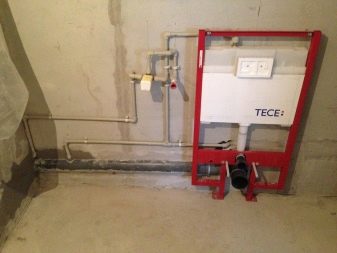
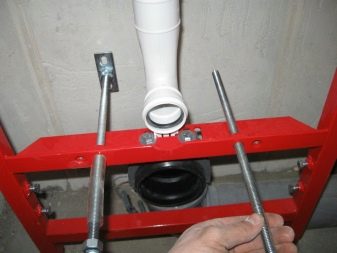
- Be sure to check if the frame is level. There should be no distortions and significant deviations from the level anywhere.
- Horizontal adjustment should be done with wall mounts.
- At this stage, the height level of the hanging toilet is also set. First of all, this parameter will depend on the growth of the household. Most often, the height of the toilet bowl in this case is 0.4 m. The height of the bowl can be adjusted at your discretion in the future.
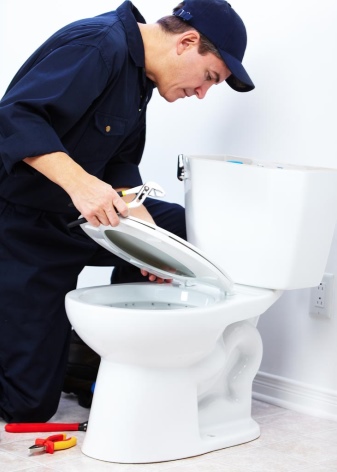
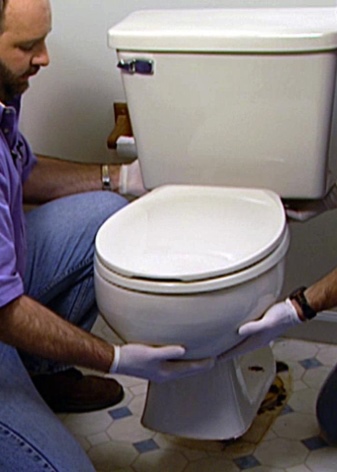
Such structures should be mounted with all responsibility. All parts of the box must be fixed as evenly, reliably and firmly as possible. Otherwise, the system may be damaged.
Sewerage and water supply connection
After fixing the toilet, you need to supply water to the cistern. For this, you can use a flexible or rigid system. The majority of specialists use a rigid supply, since it is more reliable, strong and durable. Of course, it is permissible to install flexible hoses, but if they are damaged or deformed, then it is easy to get to them and quickly remove them. During the installation of the inlet, the tank valve, like the drain, must be closed.
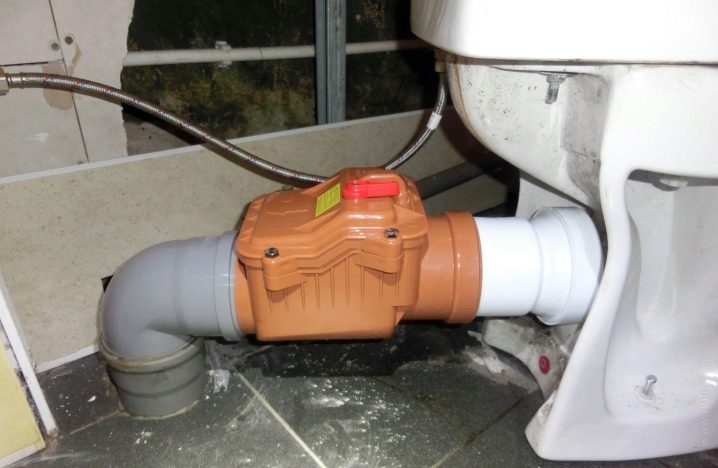
After connecting all the necessary elements, you need to check the reliability and quality of the fasteners. To do this, open the water in the tap and fill the tank. If you notice a leak, then it must be repaired. This can cause water to remain in the reservoir.
Next, you need to connect the toilet to the sewer. To do this, the drain hole of the plumbing fixture must be inserted into the outlet of the sewer pipe using a suitable corrugation. There are also models that can be assembled without using it.
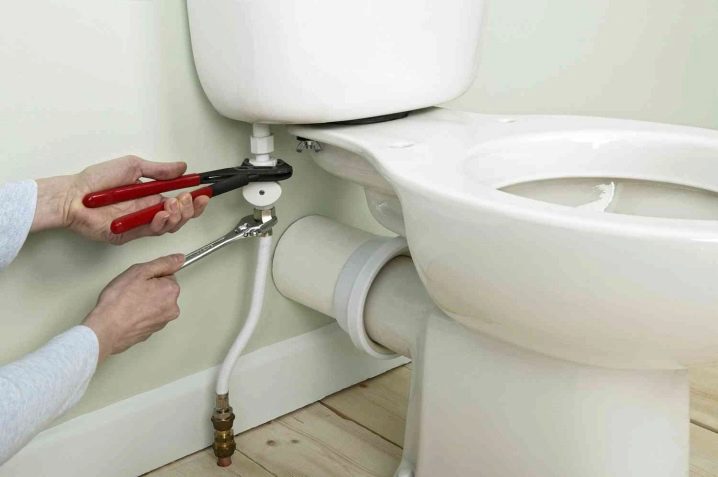
After completing all work, you should make sure that the installed system is sufficiently tight. To do this, you need to screw the bowl to the frame for a while. After that, it will need to be removed again. You can mount this part only at the end of all installation work.
Please note that the wiring of the sewer pipe must be connected before starting the installation of the installation itself. Its diameter should be 100 mm (normal). It must be laid with a special slope.
Finishing
After installing all the components, it is necessary to close the structure with a plasterboard sheet. Functional elements must be sewn up with similar sheets / panels. For the bathroom, you should buy only moisture-resistant drywall, which is more durable and wear-resistant than simple material.
To make the finish more reliable, it is recommended to screw it to the metal frame assembled from the profile, as well as the frame from the toilet bowl.
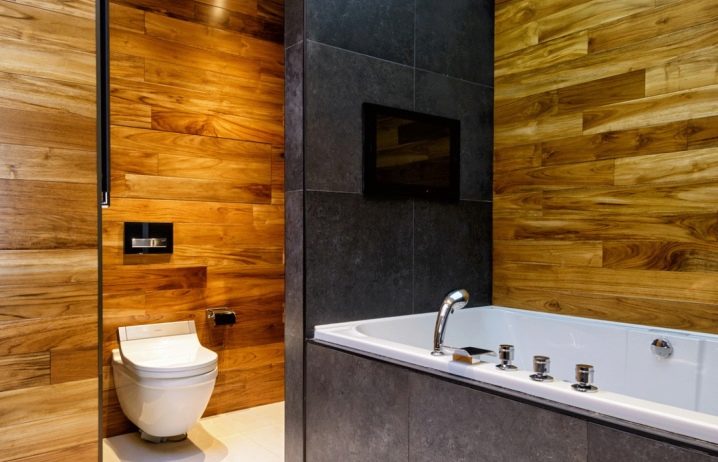
Sheathing can be done in two ways:
- over the entire overlap plane;
- only along the plane where the installation is located.
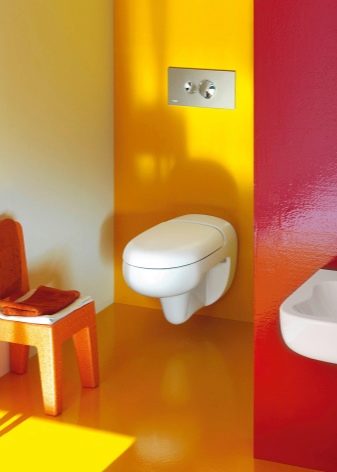
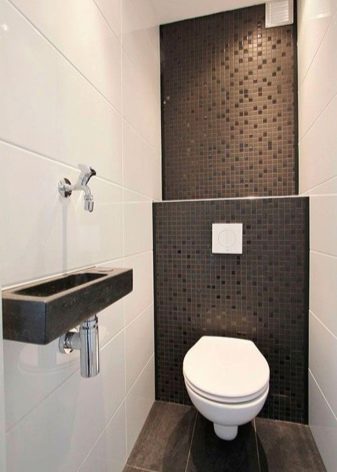
The second finishing method involves forming a small shelf directly above the bowl. It is permissible to use it to place items needed by the owners. After that, the closed barrier must be finished with tiles or PVC panels - it all depends on how the rest of the partitions in the room are decorated.
Useful Tips
As you can see, independent installation of a wall or floor installation can be done by hand. It is worth listening to some of the advice and recommendations of specialists to make the design more reliable and of high quality.
- When installing the installation, the tank is always "hidden" in the wall. However, one way or another, you will need access to it.For this, it is necessary to mount an inspection hatch. Better to place it just below the install button.
- The installation location of the button must be planned, while taking into account the layout of the tiles on the walls. It is recommended to mount this part between adjacent tiles or in the central part of one of them.
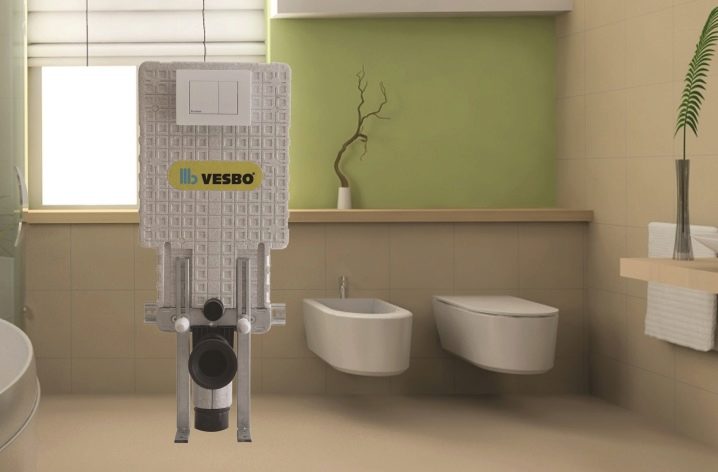
- The thickness of the structure covering the installation must be no more than 70 cm.
- Leave a distance between the plumbing fixtures. It should be 180-230 mm.
- To save water, it is recommended to select the appropriate buttons equipped with two types of drain.
- If the floor-standing toilet is leaking, then you need to make sure that the plumbing is well sealed. All joints and the connection with the corrugation should be treated with a sealant again.
- If the toilet is unstable, then you should tighten the bolts. However, this should be done more carefully so as not to break the thread.
- Most often, polypropylene pipes are used for laying. In addition, all metal risers must be replaced with plastic ones.
- Before proceeding with the installation work, it is worth drawing up detailed drawings and a diagram of the future design. This is especially important if you decide to install a complex corner installation.

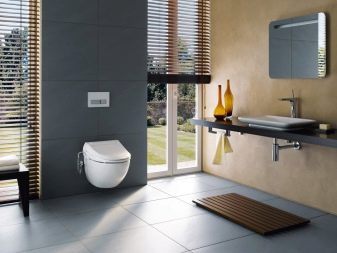
- If the bathroom is located in the central part of the living area (far from the main floors), then only a frame structure should be installed in it.
- Before installing the installation, it is advisable to change the niche and remove the risers to the corner.
- Please note that the installation of suspended plumbing should be started only 10-14 days after fixing the frame.
- When adjusting the height of the hanging toilet, it is necessary to rely on the distance from the center of the horizontal sewer outlet to the level of the clean floor. It is also necessary to take into account the slope of the pipes.
- Do not proceed with the installation of the installation until you have carefully studied the instructions that came with it.
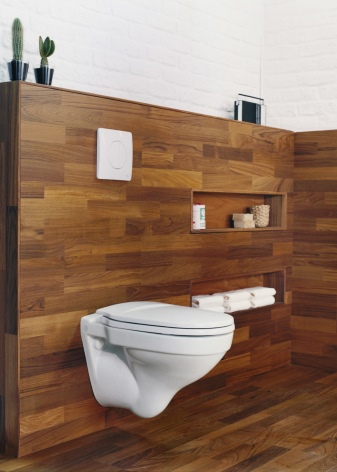
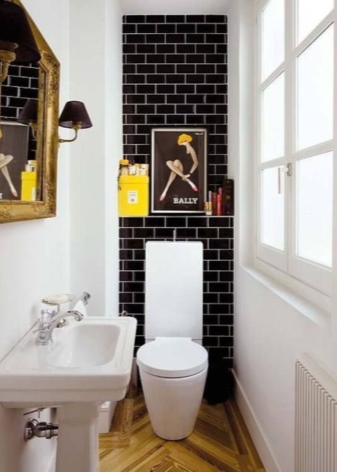
- Before installing the toilet, do not forget to make the "outlet" of the cold water pipes.
- Remember that any malfunctions in the inside of the barrel are fairly easy to identify: take a close look at all the nodes. All moving elements should "walk" without problems, the joints should be as tight and reliable as possible, the structure should not be skewed.
- The frame can only be installed after the screed and waterproofing of the floor have been made.
- It is recommended to install lower and wider installations in a wooden house. Thus, the load on the wall will be significantly reduced. Otherwise, it is better to attach the structure to the floor.
For information on how to install a wall-hung toilet, see the next video.













The comment was sent successfully.